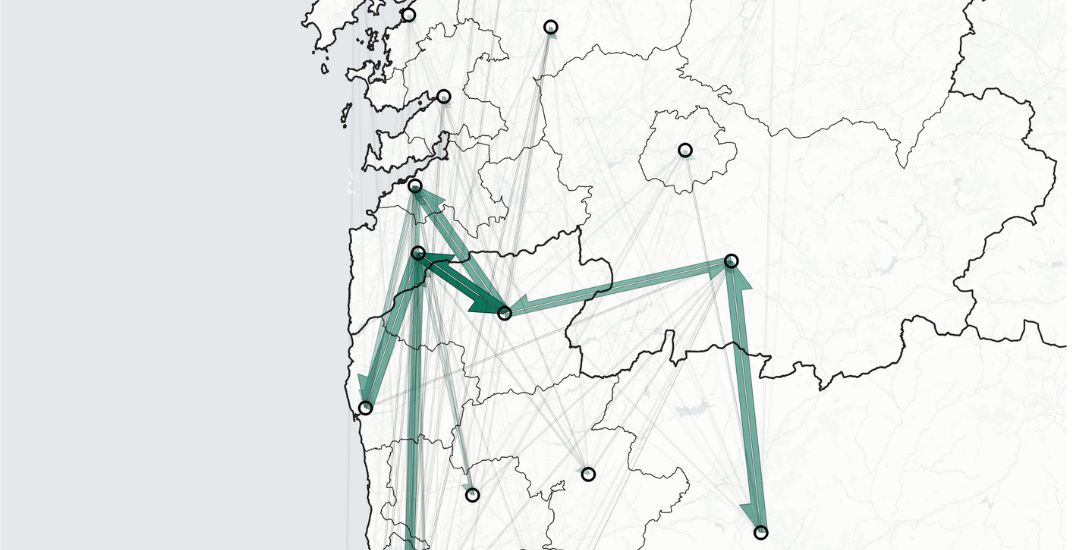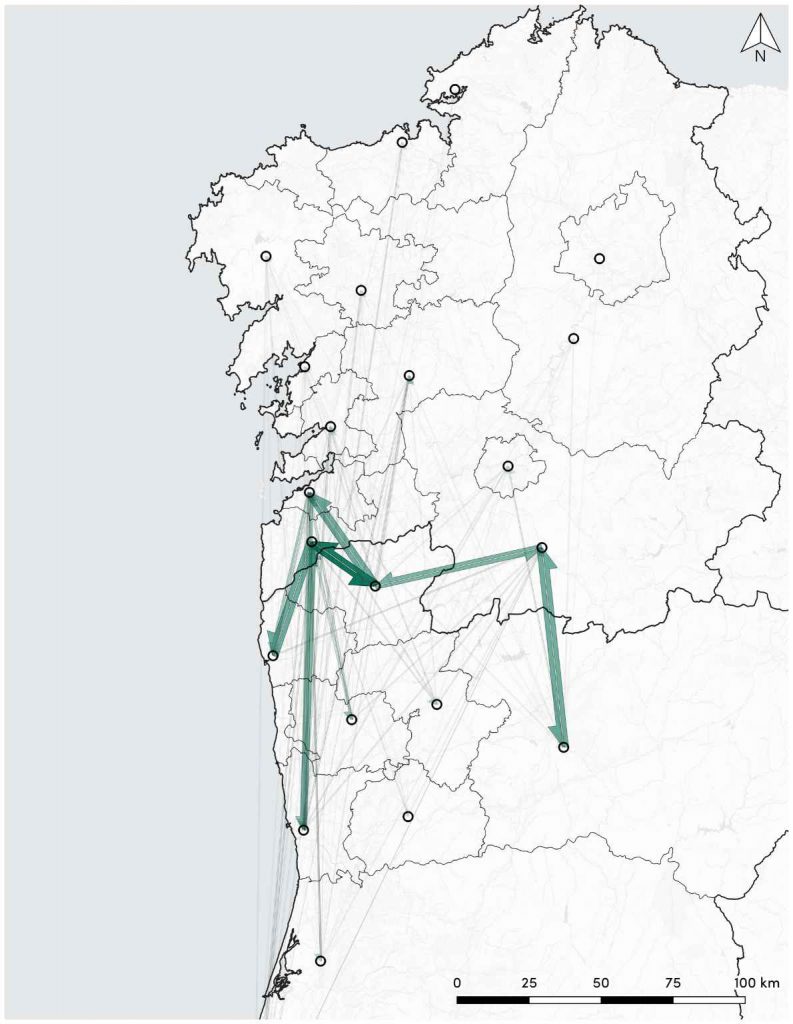One of the cornerstones of European integration is the freedom of movement between countries. The population of border regions have benefited from the possibility of working, shopping and spending leisure time on any side of national borders, leading to increasing travel demand between neighbouring countries. In the last few years, Nommon has evolved its Mobility Insights solution, which extracts travel demand indicators from mobile network data, to offer new possibilities to study mobility patterns between countries. This takes advantage of the roaming-in and roaming-out data collected by mobile network operators. This case study presents one of the projects where this has been applied: an analysis of the mobility between the Spanish region of Galicia and the north of Portugal.

Briefing
One of the cornerstones of European integration is the freedom of movement between EU countries. The population of border regions have benefited from the possibility of working, shopping and spending leisure time on any side of national borders, leading to increasing travel demand between neighbouring countries. Besides the notable improvements in highway connectivity (e.g., crossing tunnels and bridges), the European Commission is committed to boost cross-border passenger rail, both through prioritised funding for rail infrastructure linking countries (TEN-T corridors) and through dedicated support to operators to set up cross-border rail services. The initiative to support 10 pilot rail services between EU countries announced in January 2023 is a good example of how cross-border mobility is a top priority for European institutions.
In the last few years, Nommon’s Mobility Insights solution has provided cross-border mobility demand indicators to several private and public clients, in order to support feasibility studies of international transport infrastructures and services linking Spain with France and Portugal. One of these studies focused on travel demand between the Spanish region of Galicia and the Portuguese North Region. The strong socio-economic ties between these two territories and the fact that Porto airport catchment area includes Galicia generate a considerable amount of international trips. In the absence of stronger rail connectivity, road trips account for more than 90% of the demand. The focus of this case study was to identify the spatial distribution patterns of cross-border mobility between the two regions, in order to assess the potential of new rail services.
Solution
Anonymised mobile network data offer unmatched capabilities for analysing long-distance travel demand, given their large sample size, the ability to cover very large geographical areas, and the fact that they register door-to-door trips. This is especially important in corridors where car trips are predominant, as it is very costly to obtain good quality information on car trip origins and destinations from surveys. The use of mobile network data in cross-border mobility studies faces a challenge: the databases offered by mobile network operators (MNOs) are usually country-specific. Each national MNO collects the records generated by their own customers, both in the national territory and abroad (roaming-out data), but also the records generated by users from foreign countries that connect to the national network of the MNO during their stays (roaming-in data). This situation implies two limitations for cross-border mobility analyses:
- Roaming-in data only cover records in the MNO network, which is limited to one of the two countries addressed. This means that the origin and destination of the trips made by residents in the other country cannot be fully located: only the trip end located in the MNO country will be known.
- All roaming-out records can be located at least at country level (the standard identification system for the antennas include country-specific digits). The MNO has no information about the location of the abroad antennas, so the ability to locate the records will depend on the data available in open source repositories that report the location of the antennas, such as OpenCellID.
Given the increasing demand for international mobility studies, Nommon has evolved its Mobility Insights solution to integrate OpenCellID data, enabling the location of the final destination of a significant portion of the trips performed by the MND customers in foreign countries. A more detailed description of the methodology implemented can be found in the paper “A methodology for understanding passenger flows combining mobile phone records and airport surveys: Application to Madrid-Barajas Airport after the COVID-19 outbreak”, where it was applied to the identification of the destination airport of international air passengers departing from Madrid Barajas airport.
In the case of the Galicia-Portugal analysis, Mobility Insights was used to obtain a series of origin-destination matrices including trips between 13 zones in Galicia and 9 zones in the north of Portugal for an average working day and a Saturday in both a summer and a non-summer period from 2019. The OD matrices were segmented by transport mode.
Outcomes
The results provide detailed information on the mobility flows between different zones of Galicia and the northern areas of Portugal, thanks to the novel methodology for locating roaming-out mobile records. In terms of overall figures, the project helped quantify the seasonality of cross-border mobility: average working days in July registered around 30% more trips than October. This difference was even higher on weekends, reaching around 50% on Saturdays.
While short-distance trips between neighbouring zones account for a wide proportion of cross-border mobility (nearly 70%), there are medium and long-distance flows that need to be taken into account when analysing the feasibility of new rail services. Flows between the metropolitan area of Vigo and the northern Portuguese province of Alto Minho are around 7% of the cross-border mobility. The metropolitan area of Porto, located around 100 km south from the Spain-Portugal border, is the origin or destination of approximately 9% of the analysed trips between Galicia and the north of Portugal.
The analysis of trip frequency showed that most trips are occasional, although around 10% of cross-border mobility demand on average working days outside the summer period are recurrent trips. As expected, this is higher in short-distance origin-destination pairs linking neighbouring areas of the two countries, reaching around 15% between the southern area of Pontevedra province in Spain and the Alto Minho province in Portugal.

What we learnt
Cross-border mobility is drawing increasing attention from transport stakeholders in Europe, as more and more citizens living in border areas travel to neighbouring regions for work and leisure activities. The efforts aimed at enhancing cross-border transport infrastructure and services require better information on travel demand. In a context where road transport accounts for the majority of cross-border mobility, the ability to obtain fine-grained information on the origin and destination of these trips on both sides of the border becomes essential for the strategic planning of bus and rail services that effectively improve connectivity. The integration of data sources that report the location of mobile network antennas in the Mobility Insights solution has enabled a more comprehensive understanding of cross-border mobility.